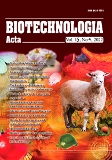ISSN 2410-7751 (Print)
ISSN 2410-776X (Online)

Biotechnologia Acta V 15, No. 4, 2022
P. 5-7. Bibliography 14, Engl.
UDC: 579.266.2+579.222
https://doi.org/10.15407/biotech15.04.005
PLANT GROWTH-PROMOTING TRAITS OF ANTARCTIC ENDOPHYTIC BACTERIA
I.O. Bortyanuy1, Ie.P. Prekrasna2, O.S. Iungin1
1Kyiv National University of Technologies and Design
2State Institution National Antarctic Scientific Center, Kyiv, Ukraine.
Successful colonization of Antarctic lands by vascular plants Deschampsia antarctica and Colobanthus quitensis and their adaptation to stressful environments is associated not only with climate change but also with the functioning of microbial groups of phylo- and endosphere of these plants.
The aim of our study was to screen plant growth-promoting traits in endophytic bacteria of antarctic vascular plants.
Materials and methods. We have studied 8 bacterial cultures isolated from D. antarctica collected during the 25th Ukrainian Antarctic Expedition (January-April 2020) along the Western part of the Antarctic Peninsula.
Overnight liquid cultures were obtained on Nutrient Broth medium (HiMedia, Ltd.) in a shaking incubator (26 ?, 160 rpm). Bacterial isolates were grown on Ashby's combined-nitrogen-free medium with sucrose. Drop collapse assay for cyclic lipopeptide production (CLP), motility assay, exoprotease production and phosphate solubilizing ability were performed using generally accepted methods.
Results. All studied isolates have shown plant growth-promoting traits. The most abundant were nitrogen-fixing activity and motility. Both these play important role in plant colonization and promoting the growth of plants in harsh environments. The evidences of CLP were shown by two strains only. There was no notice of phosphate solubilizing ability and exoprotease production.
Conclusions. Endophytic bacteria of antarctic vascular plants could support the growth and nutrition needs of the plants.
Key words. PGPB, antarctic vascular plants, endophytes.
© Palladin Institute of Biochemistry of the National Academy of Sciences of Ukraine, 2022
References
1. Compant S., Cl?ment C., Sessitsch A. Plant growth-promoting bacteria in the rhizo-and endosphere of plants: their role, colonization, mechanisms involved and prospects for utilization. Soil Biology and Biochemistry. 2010, 42(5), 669?678. https://doi.org/10.3390/biology10060475
2. Gamalero E., Glick B. R. Mechanisms used by plant growth-promoting bacteria. In Bacteria in agrobiology: plant nutrient management. Springer, Berlin, Heidelberg, 2011, pp. 17?46. https://doi.org/10.1007/978-3-642-21061-7_2
3. Olanrewaju O. S., Glick B. R., Babalola O. O. Mechanisms of action of plant growth promoting bacteria. World Journal of Microbiology and Biotechnology. 2017, 33(11), 1?16. https://doi.org/10.3390/agronomy9110712
4. Peixoto R. J. M., Miranda K. R., Lobo L. A., Granato A., de Carvalho Maalouf P., de Jesus H. E., Domingues R. M. C. P. Antarctic strict anaerobic microbiota from Deschampsia antarctica vascular plants rhizosphere reveals high ecology and biotechnology relevance. Extremophiles. 2016, 20(6), 875?884. https://doi.org/10.1007/s00792-016-0878-y
5. Mohite B. V., Patil S. V. Isolation and Identification of Nonsymbiotic Azotobacter and Symbiotic Azotobacter Paspali–Paspalum notatum. In Practical Handbook on Agricultural Microbiology. Humana, New York, NY. 2022, pp. 25?33). https://doi.org/10.1007/978-1-0716-1724-3_3
6. De Souza J. T., De Boer M., De Waard P., Van Beek T. A., Raaijmakers J. M. Biochemical, genetic, and zoosporicidal properties of cyclic lipopeptide surfactants produced by Pseudomonas fluorescens. Applied and environmental microbiology. 2003, 69(12), 7161?7172. https://doi.org/10.1128/AEM.69.12.7161-7172.2003
7. Ha D. G., Kuchma S. L., O’Toole G. A. Plate-based assay for swimming motility in Pseudomonas aeruginosa. In Pseudomonas methods and protocols. Humana Press, New York, NY.2014, pp. 59?65.
8. Vazquez S. C., Rios Merino L. N., MacCormack W. P., Fraile, E. R. Protease-producing psychrotrophic bacteria isolated from Antarctica. Polar Biology. 1995, 15(2), 131?135. https://doi.org/10.1007/BF00241051
9. Pikovskaya R. I. Mobilization of phosphorus in soil in connection with vital activity of some microbial species. Mikrobiologiya. 1948, 17, 362?370.
10. Pr?i? J., Ongena M. Elicitors of plant immunity triggered by beneficial bacteria. Frontiers in Plant Science. 2020, 11, 594530. https://doi.org/10.3389/fpls.2020.594530
11. Puri A., Padda K. P., Chanway, C. P. Nitrogen-fixation by endophytic bacteria in agricultural crops: recent advances. Nitrogen in agriculture. IntechOpen, London, GBR. 2018, 73?94. https://doi.org/10.5772/intechopen.71988
12. Li J. T., Lu J. L., Wang H. Y., Fang Z., Wang X. J., Feng, S. W., Liang J. L. A comprehensive synthesis unveils the mysteries of phosphate?solubilizing microbes. Biological Reviews. 2021, 96(6), 2771?2793. https://doi.org/10.1111/brv.12779
13. Wan C., Fan X., Lou Z., Wang H., Olatunde A., Rengasamy K. R. Iturin: Cyclic lipopeptide with multifunction biological potential. Critical Reviews in Food Science and Nutrition. 2021, 1?13. https://doi.org/10.1080/10408398.2021.1922355
14. Balleza D., Alessandrini A., Beltr?n Garc?a M. J. Role of lipid composition, physicochemical interactions, and membrane mechanics in the molecular actions of microbial cyclic lipopeptides. The Journal of membrane biology. 2019, 252(2), 131?157. https://doi.org/10.1080/10408398.2021.1922355

